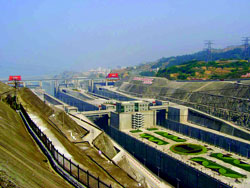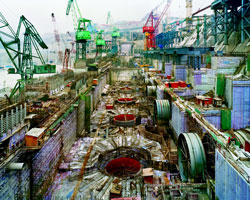Three Gorges Dam- World’s largest integrated
water project
After Great Wall of China, The Three Gorges Dam has been one of the world's largest
construction jobs. The original intent of Three Gorges Dam was for flood control.
Over the past 2,000 years, there have been more than 200 catastrophic floods along
the Yangtze's banks. The dam is also needed to provide an important source of energy
for a rapidly growing and modernizing society. China is the second-largest energy
consumer in the world, just behind the United States.
It is located in the middle of the Yangtze River, began in 1994, and its construction
cost a total of more than $26 billion and displaced at least 1.3 million people.
The enormous dam considered being extremely productive, though; with the installation
of the final turbine, the dam now has a capacity of up to 22.5 gigawatts, which
is about 11 percent of the China’s total hydroelectric capacity. It’s
the world’s biggest dam after all, with its 185 meters height and 2.3 kilometers
width. On its east and west are huge hydroelectric turbine generators that will
engage the dam’s processes.
This large dam across the Yangtze River was originally proposed by Sun Yat-sen,
the father of the modern China in The International Development of China, in 1919,
who stated that a dam capable of generating 30 million horsepower (22 GW), however,
due to political combat the project did not materialise for the construction. It
was only in 1980s, the idea of a dam reemerged and it was approved for construction
in the year 1994. The dam was expected to be fully operational in 2009, but additional
projects, such as the underground power plant with six additional generators, delayed
full operation until May 2012.
Construction facet
|
After the construction began in 1994, in November 1997, the Yangtze River was closed
with loads of huge of rocks dropped by 32-ton dump trucks into the river. The river
was diverted into a 2.3-mile-long canal, using a massive 580-meter-long, 140–meter-high
temporary coffer dam so the Three Gorges dam could be built in the river bed. In
early June 2003, China blocked the Yangtze River and began the filling in what will
be a 600-kilometer-long reservoir. Water rose at a rate of about a half centimeter
every hour until mid June when the water reached an interim level of 135 meters
above sea level, 100 meters above what it was before and commercial ships began
passing through the locks. As the water rose, the last hold holdouts gathered their
possessions and Chinese medicine suppliers gathered snakes, scorpions, and insects
scrambling in confusion as their homes were submerged.
The main wall of Three Gorges Dam was completed in May 2006, nine months ahead
of schedule, and dam was declared finished. A ceremony was held to honor 100 workers
who had died as of that time. The last cofferdam was blown up in June 2006, unleashing
water into the
|

 |
hydroelectric facilities and allowing the main dam to hold back the
full weight of the Yangtze River. The explosions, produced with 191 tons of dynamite,
sent water shooting 30 meters into the air. Before the explosions the water was
zapped with electricity to keep fish out of harm’s way. Since the start of
construction in 1992 about 16 million tons of concrete have been poured into the
giant barrier across the Yangtze River, creating a reservoir that stretches almost
the length of Britain and drives 26 giant turbines. Installation of the 26 generator
turbines and other equipment was due to be completed in 2009, when the reservoir
will reach its full level—175 meters above sea level, 140 meters higher than
it was in 2002, and 40 meters higher than what it was in 2003, and be 660 kilometers
long. The reservoir is now known as Emerald Drop Lake.
It can be termed as the largest integrated water project built in the history
of the world. The main objective of the project was to control floods, power generation
and navigation improvements. It can generate 18,000 megawatts of power, which is
eight times that of the Hoover Dam, US that is on the Colorado River. The
Three Gorges Dam can contain multiple ships at a time. The dam contains lock channels
on both sides – one responsible for controlling upriver traffic and the other
managing downriver traffic. In 2003, a one-year period of trial navigation tested
the waters surrounding the dam. Luckily, two ships had safely gone through the five-level
ship locks of the dam, marking the readiness of the dam’s operations.
Touring the Three Gorges Dam will not only give you a very unique experience but
an educational one too. The dam’s construction gives you insight in one of
the great achievements in the field of engineering.
Fact sheet
Location: Sandouping, Yiling, Hubei in China
Type of Dam: Gravity Dam
Purpose: Power, flood control, navigation
Construction cost: $26 billion
Owner(s): China Yangtze Power (subsidiary of China Three Gorges Corporation)
Height 181 m (594 ft)
Length 2,335 m (7,661 ft)
Crest width: 40 m (131 ft)
Base width: 115 m (377 ft)
Impounds: Yangtze River
Spillway capacity: 116,000 m3/s